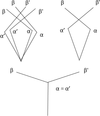issue contents
November 2021 issue

Cover illustration: The structures are reported for four new solvates of the anti-HIV compound etravirine with dimethyl sulfoxide (two distinct solvates), 1,4-dioxane and N,N-dimethylacetamide, which exhibit conversion to the same anhydrous etravirine phase upon desolvation, and a stable etravirinium oxalate salt, and the intermolecular interactions were explored by Hirshfeld surface analysis. See Muresan-Pop, Macavei, Turza & Borodi [Acta Cryst. (2021), C77, 698–706].
research papers












 access
access




 journal menu
journal menu

























